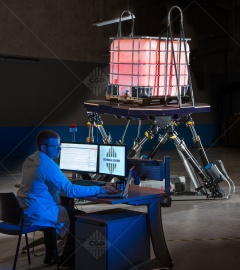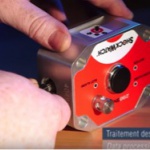Logistics testing center
A test center built into our innovation process.
A LOGISTICS TESTING CENTER
- Transport simulators.
- Assessment of logistical stresses in sea, rail, air or road transport
- Reproduction of forces experienced during handling, storage, conveying, stacking, impacts, vibrations, rolling, etc.
- Dynamic and physical testing under real, permanent or accidental stress
Aims:
- Prevent damage.
- Evaluate the performance, the reliability and features of packaging.
- Validate packaging and securing solutions under endurance and fatigue conditions.
- Validate packaging and securing solutions under exceptional situations.
- Avoid overwrapping.
- Optimize packaging.
- Generate savings.
THE TECHNICAL TESTING CENTER provides technical support to packing, packaging and transport industries and to their industrial users.
We carry out physical, mechanical and climatic stress testing on packages, materials and products.
Our mission is to help our customers prevent material and human damage caused by poorly specified packaging or defective securing, and also avoid overwrapping and over-securing of products.
TESTING, DEVELOPING, VALIDATING under actual stress conditions
A packaged, palletized and shipped product will go through various steps during its logistical life: handling, storage, loading, transport, etc.
- QUALIFICATION
What better way to test your choices in terms of packaging and securing than shipping your pallets to the other end of the country or the planet? But, testing in actual road and sea transport is expensive, and is subjected to the vagaries of transport.
By using the services of the TECHNICAL CENTER, you can ensure that logistical stresses, specifically those experienced by your loads, are reproduced and analyzed in a repeatable and objective manner.
- OPTIMIZATION
Transport stresses can be applied to the same type of load using different packaging, palletizing and securing solutions. The strengths and weaknesses of each solution can be identified in this manner and solutions can be compared with each other.
The TECHNICAL CENTER allows you to recreate the stresses experienced by your loads in the logistics chain:
- compression (storage and stacking stress)
- impacts (handling stress)
- vibration and inertial forces (transport stress)
The TECHNICAL CENTER has the capacity to follow ISTA validation protocols (International Safe Transit Association) on pallets as a unit load such as ISTA 1E and ISTA 3E. But to test pallets in actual transport conditions and avoid over-qualified and expensive solutions being recommended, the TECHNICAL CENTER brings its test facilities closer to actual transport conditions.
HEXAPODE: 6-axis vibrating test rig.
Simulation performed in the TECHNICAL CENTER on a full-size pallet loaded with your products.
Vibrating table with rotation in 3 directions.
Aim:
Based on the data recorded during actual transport, HEXAPODE faithfully reproduces all the stresses experienced by your palletized loads (starting, acceleration, cornering, roundabouts, braking, etc.), in a controlled working environment.
- Capacity: 1.5 metric ton
- Frequency range: 0-50 Hz
- Maximum travel: ± 400 mm
- Platform dimensions: 2,100 mm x 2,100 mm x 2,400 mm
- Maximum load height: 2.40 m
IMPACT TEST
Simulation performed in the TECHNICAL CENTER on a full-size pallet loaded with your products.
Impact test reproducing accidental events (forklift impacts, stop-and-go conveyor movement, truck in an emergency braking situation).
Aim: replication of decelerations, impacts and shocks.
Analysis of the data recorded and filmed for each interface: floor/pallet, pallet/product, product/product.
Backed by our engineers many of whom have more than 20 years of experience in understanding the behavior of pallets and loads, we offer you custom protocols developed:
- based on the CGP COATING INNOVATION database
- based on the records of stresses experienced by a pallet shipped from your plant until its final destination.
Recording
The first step consists in you choosing the flow you want to replicate (flow with the highest rate of non-conformities, the largest flow in terms of volume transported, etc.). The stresses are recorded using the data sensors that we will lend to you. These sensors will be packed specifically to be placed in the heart of your pallets. This load will be shipped in the flow of your choice. The sensors will record vibrations, impacts, temperature and humidity during the entire transport.
Analyzing and creating the signal
Once the sensors are returned to the TECHNICAL CENTER, the recorded data will be analyzed to identify risks and stresses specific to your logistics chain.
The data will be used to create a signal in order to replicate these stresses. This signal can be used as many times as desired to assess the ideal packing and securing methods according to your quality criteria.
The TECHNICAL CENTER is equipped with state-of-the-art wrappers to reproduce the wrapping of your pallets in the same manner as your usual practice (pre-stretch rate up to 400%, varying clamping depending on the pallet height, etc.). After being wrapped, the pallets will go through each of the test benches specified in the protocol.
On completion of the tests, we will analyze the behavior of your products and give you practical tips for optimizing your packaging, palletization and securing processes (modifying the palletizing plan, loading plan, amount of stretch film used, types, number and positioning of anti-slip sheets, modifying the quality of the cardboard boxes, etc.)
The protocol includes 2 phases:
- Acquisition of transport stresses.
- Analysis and interpretation of transport data, definition of testing conditions.
Phase A: Acquisition of transport stresses.
The objective of this phase is to record the various stresses to which the palletized load is subjected.
To this end, the customer must define one or more routes considered significant. These are mostly routes with high levels of logistical incidents, or routes known to be particularly traumatic for palletized loads.
The load is then placed on a pallet equipped with sensors. This pallet is called the "cookie pallet". The "cookie pallet" is shipped to monitor the significant route the customer has chosen. On arrival, the loads are de-palletized, and the "cookie pallet" is sent back to the Technical Center.
Phase B: Analysis and interpretation of transport data, definition of testing conditions.
The data recorded in the sensors is extracted by a qualified technician at the Technical Center. This data will undergo post-processing. The processing will help define the types of stresses experienced by the pallet: inertial forces, low and high frequency vibrations, impacts.
A report is issued with the main findings and recommends the test(s) to be performed to simulate the transport conditions.
















